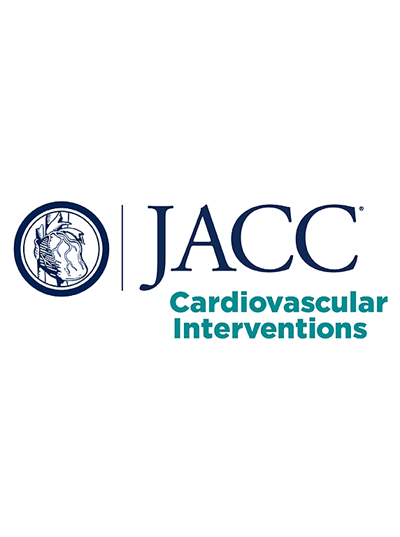CLASP IID试验和注册
IF 11.4
1区 医学
Q1 CARDIAC & CARDIOVASCULAR SYSTEMS
引用次数: 0
摘要
CLASP IID试验(Edwards PASCAL经导管瓣膜修复系统关键临床试验;NCT03706833)和Registry为期一年的结果表明,PASCAL经导管瓣膜修复系统是一种安全有效的治疗禁止性退行性二尖瓣反流(DMR)的方法。长期随访正在进行中。目的:本文报道CLASP IID试验和注册2年结果。方法在CLASP IID试验中,3+/4+ DMR的禁止风险患者被认为适合PASCAL和MitraClip系统,以2:1随机分配(PASCAL: n = 204; MitraClip: n = 96)。解剖结构复杂的患者被认为不符合随机分组的条件,纳入CLASP IID Registry (N = 98)并接受PASCAL系统治疗。结果在随机队列中,在2年时实现了显著且持续的MR降低。PASCAL组MR≤2+率为95.0% (96/101),MitraClip组为91.5% (54/59)(P = 0.500), MR≤1+率为77.2% (78/101),MitraClip组为67.8% (40/59)(P = 0.198)。Kaplan-Meier估计全因死亡率、心血管死亡率、心力衰竭住院和非选择性二尖瓣再干预的自由度分别为80.8%对86.2% (P = 0.216)、88.6%对90.4% (P = 0.666)、86.4%对94.3% (P = 0.058)和97.9%对97.9% (P = 0.962)。在注册队列中,91.9%(34/37)的患者MR≤2+,64.9%(24/37)的患者MR≤1+。Kaplan-Meier估计全因死亡率、心血管死亡率、心力衰竭住院率和非选择性二尖瓣再干预的发生率分别为77.2%、84.0%、85.1%和99.0%。两组患者的功能状态和生活质量均有显著改善。CLASP IID试验和注册的两年结果显示良好的生存期,显著和持续的MR降低,功能和生活质量的改善,证实了PASCAL系统在治疗大量DMR患者中的持续安全性和有效性。本文章由计算机程序翻译,如有差异,请以英文原文为准。
CLASP IID Trial and Registry
Background
One-year outcomes from the CLASP IID Trial (Edwards PASCAL TrAnScatheter Valve RePair System Pivotal Clinical Trial; NCT03706833) and Registry established the PASCAL transcatheter valve repair system as a safe and effective treatment for prohibitive-risk degenerative mitral regurgitation (DMR). Longer-term follow-up is ongoing.
Objectives
This paper reports the CLASP IID Trial and Registry 2-year outcomes.
Methods
In the CLASP IID Trial, prohibitive-risk patients with 3+/4+ DMR, deemed suitable for both the PASCAL and MitraClip systems, were randomized 2:1 (PASCAL: n = 204; MitraClip: n = 96). Patients with complex anatomy deemed ineligible for randomization were enrolled in the CLASP IID Registry (N = 98) and treated with the PASCAL system.
Results
In the randomized cohort, significant and sustained MR reduction was achieved at 2 years. MR ≤2+ rate was 95.0% (96/101) in the PASCAL group vs 91.5% (54/59) in the MitraClip group (P = 0.500), and MR ≤1+ rate was 77.2% (78/101) vs 67.8% (40/59) (P = 0.198), respectively. Kaplan-Meier estimates for freedom from all-cause mortality, cardiovascular mortality, heart failure hospitalization, and nonelective mitral valve reinterventions were 80.8% vs 86.2% (P = 0.216), 88.6% vs 90.4% (P = 0.666), 86.4% vs 94.3% (P = 0.058), and 97.9% vs 97.9% (P = 0.962), respectively. In the registry cohort, 91.9% (34/37) achieved MR ≤2+ and 64.9% (24/37) achieved MR ≤1+. Kaplan-Meier estimates for freedom from all-cause mortality, cardiovascular mortality, heart failure hospitalization, and nonelective mitral valve reinterventions were 77.2%, 84.0%, 85.1%, and 99.0%, respectively. Significant improvements in functional status and quality of life were observed in both cohorts.
Conclusions
Two-year outcomes from the CLASP IID Trial and Registry show favorable survival, and significant and sustained MR reduction with functional and quality-of-life improvements, confirming sustained safety and effectiveness of the PASCAL system in treating a broad population of DMR patients.
求助全文
通过发布文献求助,成功后即可免费获取论文全文。
去求助
来源期刊

JACC. Cardiovascular interventions
CARDIAC & CARDIOVASCULAR SYSTEMS-
CiteScore
11.60
自引率
8.80%
发文量
756
审稿时长
4-8 weeks
期刊介绍:
JACC: Cardiovascular Interventions is a specialist journal launched by the Journal of the American College of Cardiology (JACC). It covers the entire field of interventional cardiovascular medicine, including cardiac, peripheral, and cerebrovascular interventions. The journal publishes studies that will impact the practice of interventional cardiovascular medicine, including clinical trials, experimental studies, and in-depth discussions by respected experts. To enhance visual understanding, the journal is published both in print and electronically, utilizing the latest technologies.
 求助内容:
求助内容: 应助结果提醒方式:
应助结果提醒方式:


